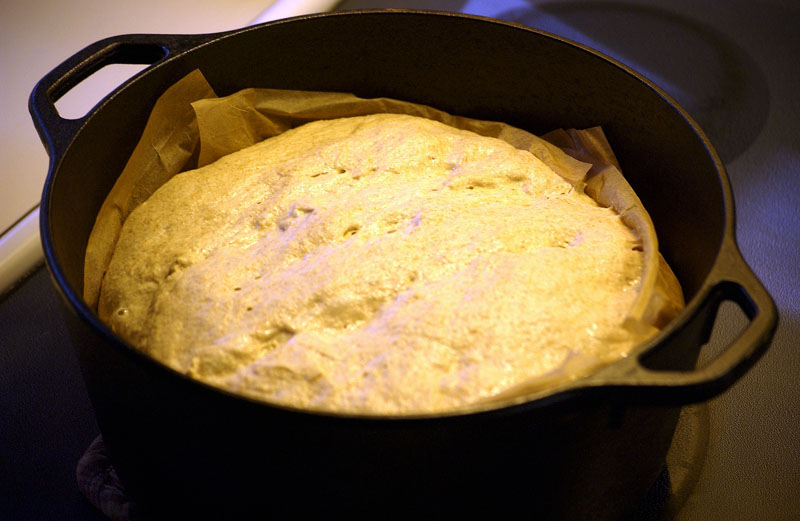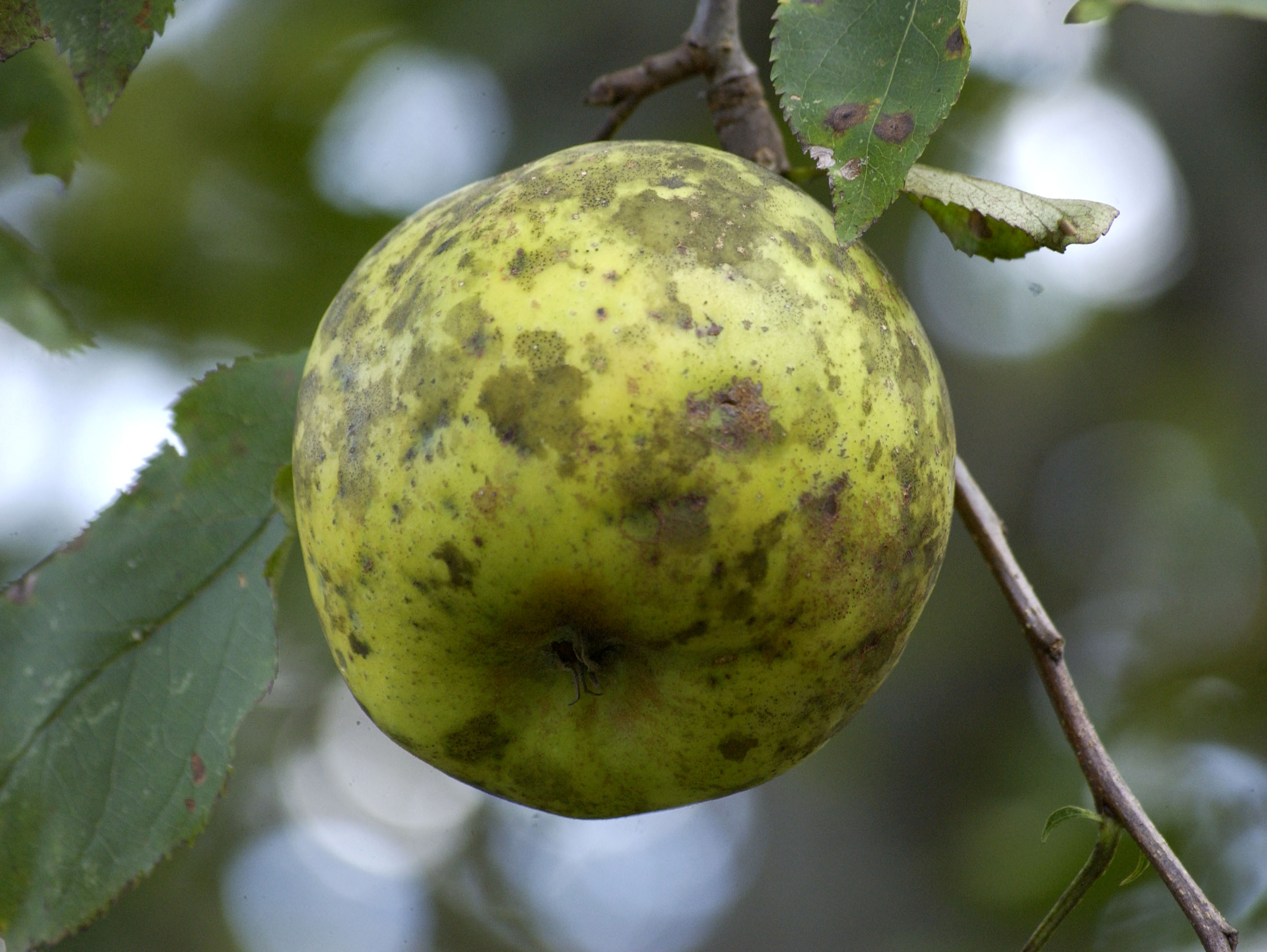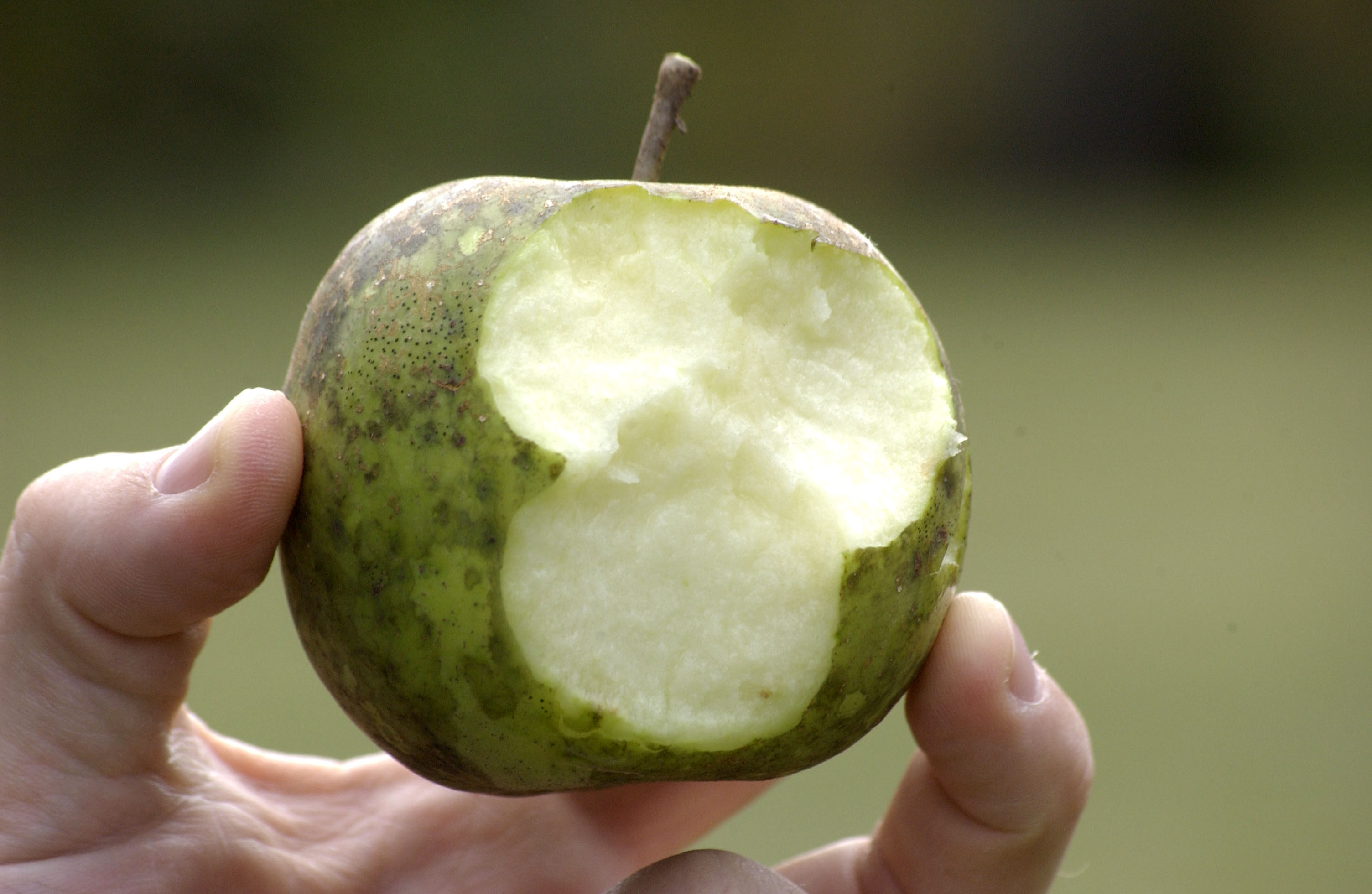The long-range forecast calls for normal-ish temperatures and above-normal precipitation, so Ken planted the early garden today.
Spring has sprung.
I hope.
Watching a bewildering world from the middle of nowhere
The abbey is rich with eggs, so eggs are the default breakfast. But variation is needed. The French divide breakfasts into two broad categories — sweet breakfasts and salty breakfasts. Sweet breakfasts are awfully good sometimes, but it’s hard to keep sweet breakfasts from being cloying. Or they’re just too high carb, and one starts craving a high-carb lunch.
These banana-walnut broiler cakes are not exactly low carb, but they’re not as high carb as they look. Each cake contains only about 4 ounces of batter. The rest of it is banana and toasted walnuts.
Here’s a rough recipe.
1. Toast a generous quantity of walnuts in a skillet and set them aside.
2. Make a portion of your favorite pancake batter, but not too much. The cake in the photo was made with blue cornmeal batter.
3. Slice a banana into quarters and start browning the slices in a skillet. Use an interesting oil such as coconut oil.
4. When the bananas start to brown, throw on the toasted walnuts.
5. Pour on the batter.
6. When the bottom of the cake is nicely browned, pop the pan under the broiler.
7. Brown the top of the cake under the broiler. When it’s done, flip it onto a plate. The side that was browned in the skillet on the stovetop will be the prettiest side, so turn that up. The cake will fall apart, but that’s a feature, not a bug.
8. If you’re making more than one, keep them warm on the bottom rack of the oven, away from the broiler.
9. Serve ’em with butter and maple syrup.
These hotcakes are delicious, with a complex blend of flavors and textures. The toasted walnuts give it a roasted flavor. Browned bananas are divine. The coconut oil really brings out the walnut and banana flavors. And how can you go wrong with maple syrup?
By the way, Trader Joe’s has good bargains in Canadian maple syrup. I buy Grade B syrup. Grade B is not inferior. It’s just a little heavier and has a sassier taste than Grade A. And it’s cheaper.
Last week, Ken told me that he saw eggs at Whole Foods that cost more than $10 a dozen. I just had to see that for myself, so today I looked for them in the egg section. The most expensive eggs I saw were $7.99 a dozen. But, luckily, Whole Foods’ egg guy was there refilling the shelves, and I got to ask him some questions.
Yes indeed, he said. Last week they had eggs that cost more than $10 a dozen. But they already had sold out! I asked him what it was about the eggs that justified the price. He called this the “resume” of the eggs. The $10 eggs, he said, were (if I and he understood correctly) from grass-fed hens. Both he and I found that a bit strange. Grass-fed cows are a good thing, because cows are ruminants, and grass is their natural food. It’s different with chickens, though. Chickens do love grass, but it’s not something that they want to live on exclusively. From my reading on chicken husbandry, I understand that chickens will happily derive about a third of their calories from grass. But they also want seeds and any tasty worms, grubs, or insects that they can find. Not to mention kitchen scraps. So I’m skeptical about the concept of grass-fed chickens.
Today, the most expensive eggs at Whole Foods were the $7.99 eggs, and I understood that the $7.99 eggs came from the same North Carolina farm (in Durham) that the $10 eggs came from.
But this is amazing. People will pay more than $10 a dozen for eggs! Ken and I really wanted to sample those eggs, because we both believe that they couldn’t possibly be superior to the eggs laid by Acorn Abbey’s happy pastured hens. But that test will have to wait. So far, the Whole Foods guy said, they have not been able to get more of the $10 eggs, though they’re trying.
Ken keeps a spreadsheet that he calls “Abbey economics,” and in the spreadsheet he tracks the cost of keeping our hens vs. the value of the eggs. One thing is for sure. The abbey’s economics look a whole lot better if you value our amazing eggs at $10 a dozen. At that price, we’re probably saving money by having our own hens.
If Southerners still ate traditional Southern cuisine cooked at home, the statistics on our health wouldn’t be what they are. You only have to look at what people have in their carts at the grocery store to see that almost nobody cooks from scratch anymore. I have a lot of doubts about whether young people really learn to cook at all anymore. Often on Facebook I see pictures of dishes that I suspect pass for home cooking these days — concoctions of grated cheese, sausage, and biscuit mix, for example.
In this area, one of our cultural resources is the K&W Cafeteria, a regional chain that started in Winston-Salem in the 1930s, I believe. It’s been over 40 years since I first ate at a K&W, and almost nothing has changed. They do Southern cuisine pretty much from scratch, striking a pretty good balance between honesty of the cuisine and the low prices that people expect around here.
Many people look down on the K&W and wouldn’t want to be seen there. I am not among them. As a matter of fact, I’m a reverse snob when it comes to the K&W. When I have visitors from out of town (with the occasional exception of Californians), I almost always take them to the K&W to help acquaint them with traditional Southern cuisine. It was the favorite eating place of a friend from Europe (who made fun of restaurants that are considered fancy in these parts). And even those who look down on places popular with seniors and people of modest means have to grant that, at least, the K&W is not fast food.
Recently they started having lunch specials. One of those specials is four vegetables, plus bread and a drink, for $5.99. Today for lunch I had pinto beans (with onions), mashed potatoes, green beans, broccoli, corn bread and iced tea. How could you go wrong?
Previously in this blog I’ve expressed the opinion that the prevalence of gluten intolerance is exaggerated. Less than 1 percent of the population has coeliac disease. Still, gluten sensitivity seems to be increasing. Something must be going on. What could that be?
Recently I came across an article about a renegade MIT scientist who has a new theory about this. She thinks that the gluten problem is caused by glyphosate — that is, the herbicide Roundup, which is made by Monsanto and other companies.
I have no way of knowing whether this theory is valid. However, this scientist mentions a fact that is new to me, and it’s shocking. That is that wheat farmers are spraying Roundup on their crops just before harvest, to dry out the wheat and make the harvest process easier for the combine machine.
When I first read this, I was skeptical that farmers would do anything so obviously dangerous. But a little Googling shows that, not only is it true, Monsanto promotes this use of Roundup as a way of boosting combine output by up to 30 percent. How long Roundup persists on plants and soil after it is sprayed is highly variable. Under some conditions, it takes months for it to break down. When Roundup is sprayed on a field to clear weeds before planting, there probably is usually time for the Roundup to mostly break down before the crop reaches our kitchens.
However, if Roundup is sprayed on wheat three or four days before harvest, you can be very sure that it remains in the wheat, and therefore in the flour, until we eat it.
I take two lessons from this.
First is that our industrialized farmers cannot be trusted. If poisoning us yields them higher profits, then they’ll poison us. Unless we’re paying attention, we won’t know what they’re doing.
Second is that, from now on, I will use only organic wheat.
I thought that all the old-fashioned drug store lunch counters had closed long ago. But I discovered today that there’s one in Walnut Cove at Hick’s Pharmacy. It’s called the Red Rooster. I asked one of the women who works there why there is no sign out front. She said there is — the red rooster logo. I guess all the locals knew that. And now that I know, I guess that makes me a local too. As far as I know, Hick’s Pharmacy is locally owned and not part of a chain. So that’s where I’ll do business hereafter.
Today’s lunch special was pinto beans, slaw, and corn bread for $4.50. I had it with onions.
I am still grieving for the basil of summer and the amazing pestos it made. Carrying pesto into the winter is greatly to be desired, not least because pesto is the best vehicle I know for delivering intense quantities of medicinal garlic. Kale, and, or, parsley are the usual winter substitutes. I can’t get excited about that, though I need to try it. This pesto is made from sun-dried tomatoes, plus the usual pesto ingredients — walnuts, parmesan, garlic and olive oil.
To be honest, it’s a little cloying. But that may be a good thing, because it reduces the temptation to eat too much.
It occurs to me that a bit of red miso substituted for part of the salt would be a good lick. I’ll try that next time.
For a while I had forgotten about sprouts. But I remembered recently while at Whole Foods, puzzling over what sort of winter salad fixin’s were freshest and cheapest. Whole Foods’ salad fixin’s were fresh, but they weren’t cheap. So I ordered fresh sprouting seeds from SproutPeople.org, got out my sprouting jars, and got back into the habit.
If you order from SproutPeople, complain in the comments box at checkout that their shipping prices are too high. They’re trying to get everyone to order more than $60 worth to get free shipping. That’s a lot of seeds to order at once.
During a couple of early cold snaps, I learned that making sourdough bread takes forever in a cold kitchen. Though all the experts seem to like the idea of a long, slow rise, I don’t have forever. The leaven process must complete overnight, and the rest of the job must be done in time to bake by 5 p.m. or so the next day.
The method I’ve hit upon is to let the dough rise in the oven with the oven light on. Then things seem to happen at about the same rate as during the summer. And while I’m at it, I set a jar of clover sprouts in the oven with the dough. All seeds (as far as I know) germinate better when they’re warm.
The standard abbey sourdough loaf is big — about three pounds. It’s half whole wheat. The whole wheat dough rises nicely, but I don’t get much oven spring with half whole wheat. The crumb is far from dense, though, and it’s great hot, cold, or as toast. When there’s company, or for a showy loaf, I use unbleached flour. That makes a much higher loaf with dramatic oven spring.

The thermostat on a typical winter morning

The dough doubles after about four hours in a warm oven

Ready to put the lid on and bake. The parchment is for lifting the dough out of the bowl into the Dutch oven. Lining the dough-rising bowl with parchment, then lifting by the edges of the paper, is the only way I’ve found to transfer the dough to the Dutch oven, which is preheated to 500 degrees. Upending the dough bowl over the Dutch oven deflates the dough.

What an apple should look like
Someday the abbey’s orchard will have a stand of grand old apple trees that will supply a variety of apples from late summer until fall. But unfortunately the abbey’s orchard is only five years old. Though it’s producing apples, the young trees can’t make apples faster than the squirrels can sneak over the fence from the woods and carry them off (along with the figs).
Therefore, whenever we’re out and about, Ken and I are on the lookout for abandoned apple trees. On a recent trip to Asheville, we hit the jackpot. There were two grand apple trees — a green and a red — near a friend’s house, and he had been given picking rights by the owner.
I won’t repeat my rant about the worthlessness of grocery store apples. I’ll just summarize with the fact that, whatever they are, they are not apples. I will make do with commercial apples when I can’t get anything else. But the only real apples come from old, abandoned trees. The age of the tree helps ensure that the apples are of an honest variety meant for eating rather than shipping. And being abandoned ensures that they’ve never been sprayed. A healthy apple tree is remarkably pest free. The ugly skin of the apple is the truest indicator of its quality. An apple with a beautiful skin is hardly ever fit to eat.

These apples were at the perfect time for picking. They were hard and very juicy.